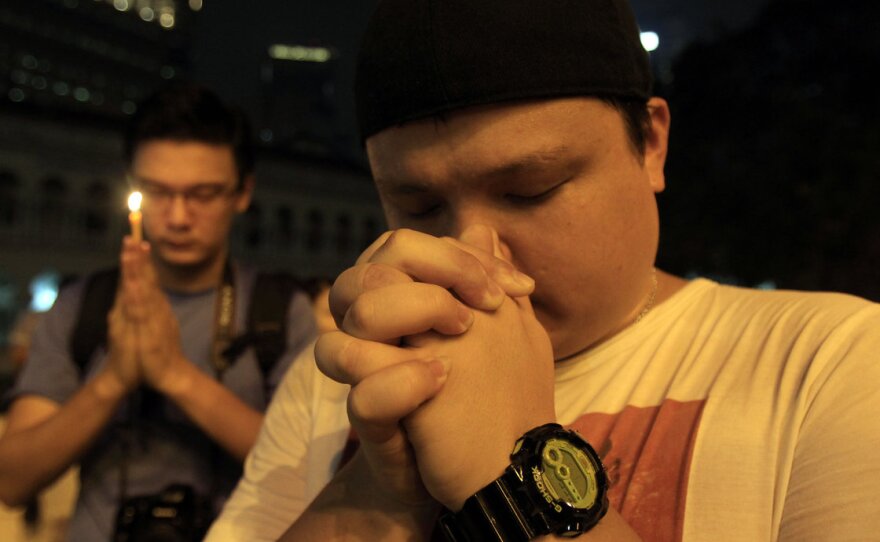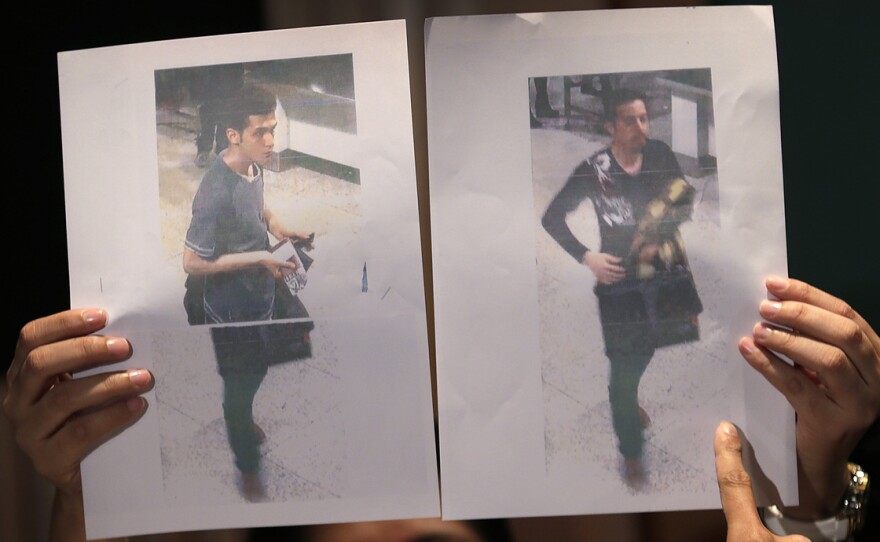There's no sign yet of Malaysia Airlines Flight 370 — the Boeing 777 with 239 people aboard that disappeared early Saturday while on a flight from Kuala Lumpur to Beijing. But there's potentially significant news from the head of Malaysia's air force, who's being quoted as saying the jet was hundreds of miles off course when it was last seen on radar.
Tuesday's news about the flight and the search for clues to its disappearance includes:
— An Hour In The Wrong Direction? Gen. Tan Sri Rodzali David, chief of Malaysia's air force, told reporters Tuesday that data from military radar at the time of the plane's flight have led authorities to extend the search to the Strait of Malacca on the western side of the Malay Peninsula, Malaysia's Berita Harian newspaper reports.

Reuters adds that Berita Harian quoted the general "as saying the plane was last detected at 2.40 a.m. by military radar near the island of Pulau Perak at the northern end of the Strait of Malacca. It was flying about 1,000 meters lower than its previous altitude, he was quoted as saying."
If the plane was in that area, that means it was in the air at least an hour longer than officials previously thought, and that it had turned west and was at least 200 miles off course.
Note: This section about the possibility that the plane was far off course was added at 8:20 a.m. PT. We should point out that, as often happens when stories such as this are developing, information may come in that later turns out to have been incorrect. That includes information from presumably well-informed officials such as this general. We'll continue to sort through what's out there and update if things change.
Our original post — No Terror Link Seen Between Stolen Passports, Missing Malaysian Jet — continues:
— Stolen Passports. There's word that Malaysian authorities believe the two passengers on board who had stolen passports "were Iranians who authorities believe were trying to migrate to Europe," as the Los Angeles Times writes.

One of the men, NPR's Frank Langfitt reports from Shanghai, has been identified as 19-year-old Pouria Nour Mohammad Mehrdad. Frank tells our Newscast Desk that the young man was apparently "flying from Kuala Lumpur, through Beijing and Amsterdam, to Frankfurt, where his mother was waiting for him."
Malaysia's inspector general of police, Tan Sri Khalid Abu Bakar, said Tuesday that "we believe he is not likely to be a member of any terrorist group and we believe he [was] trying to migrate to Germany."
"The other man traveling on a stolen passport was not named," the Times adds, but authorities believe he too was an Iranian trying to immigrate to Europe.
The news that at least two people on board had stolen passports led to speculation about the possibility they were connected to a terrorist organization. But as NPR's Brian Naylor reported on Morning Edition, stolen passports and other fraudulent travel papers are a growing problem around the world and are used for a wide variety of reasons.
— Expanded Search. Malaysian authorities, as well as "search teams from Australia, China, Thailand, Indonesia, Singapore, Vietnam, Philippines, New Zealand and the United States of America" are now looking for signs of the jet on "both sides" of the Malay peninsula, Malaysian civil aviation chief Azharuddin Abdul Rahman said Tuesday.
The airline said Tuesday that searchers are also looking "on land in between" — that is, on the Malay peninsula between the South China Sea and the Malacca Strait. According to the airline, "the authorities are looking at a possibility of an attempt made by MH370 to turn back to Subang," an airport on the peninsula.
— Four Focuses. It likely won't be until the plane is found that investigators can start to figure out exactly what happened and whether some sort of catastrophic mechanical failure was responsible for its disappearance. But as the investigation continues, police in Malaysia are also concerned about four possibilities, the inspector general said Tuesday: "hijacking, sabotage, personal problems among the crew and passengers, and psychological problems among the crew and passengers."
— No Missing Passengers. Also Tuesday, Malaysia Airlines sought to correct earlier reports about five passengers who allegedly checked in, had bags put on the flight, but then did not board the plane. Those earlier reports indicated that the bags supposedly put on board were removed before the plane took off. But the airline now says that "there were four (4) passengers who had valid booking to travel on flight MH370, 8 March 2014, but did not show up to check-in for the flight." Since they had not checked in, those four did not have any baggage that needed to be removed from the jet, the airline says.






